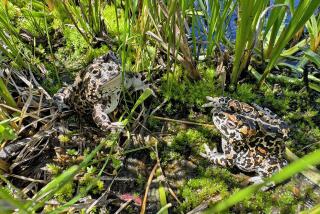NONFICTION - July 10, 1994
- Share via
TRACKING THE VANISHING TREE FROGS: An Ecological Mystery by Kathryn Phillips (St. Martin’s Press: $22.95; 244 pp.) They’re disappearing, the foothill yellow-legged frogs, the common bullfrogs, the Yosemite toads, Cascade frogs, leopard frogs, and western toads. One half of the 21 species native to California are in decline. Herpetologists from all over, perplexed at the continued disappearance of species that had been on the planet for between 150 and 200 million years, met in February 1990 in Irvine, California and exchanged anecdotes. From there, several, including the two scientists that Phillips travels with, Mark Jennings and Marc Hayes, went on to document the probable causes for the disappearance of several species. Development, acid rain, deforestation and pesticide poisoning are probable causes. But the most likely cause emerging from available data is ozone depletion and climate change. Scientists measuring stress caused by increased exposure to UV-B radiation found that frogs could respond to and avoid it in the lab but not in the wild. Their body temperature is regulated by their environment, and unfortunately, they like to sunbathe! Still other experiments showed the immediate effects of increased radiation on eggs and tadpoles. While many claim that there is insufficient evidence that frogs can serve as “bioindicators”--canaries in the rapidly warming coal mine we all live in--that speculation is not entirely unfounded. Like Douglas Hand in “Gone Whaling” (above), Phillips shows, along the way, the difference between the leaders or pioneers in a field (often scientists not attached to institutions), and the followers. Jennings and Hayes were successful in their efforts (against a recalcitrant U.S. Fish and Wildlife Service) to get at least one species, the California red-legged frog, listed as threatened, but “a 1990 audit by the U.S. Department of the Interior’s Inspector General found six hundred candidates that the Fish and Wildlife Service deemed eligible for listing had not been listed. ‘During the last ten years,’ the audit said, ‘at least thirty-four animal and plant species have been determined to be extinct without ever having received full benefit of the (Endangered Species) act’s protection.” Canary in the coal mine or not, they aren’t the only species that likes to sunbathe.
For the record:
12:00 a.m. July 31, 1994 FOR THE RECORD
Los Angeles Times Sunday July 31, 1994 Home Edition Book Review Page 11 Book Review Desk 1 inches; 32 words Type of Material: Correction
Again in the same issue (July 10), the book identified in “In Brief” as “Tracking the Vanishing Tree Frogs” is titled simply “Tracking the Vanishing Frogs.” The tree apparently grew up there overnight while we weren’t looking.
More to Read
Sign up for Essential California
The most important California stories and recommendations in your inbox every morning.
You may occasionally receive promotional content from the Los Angeles Times.










